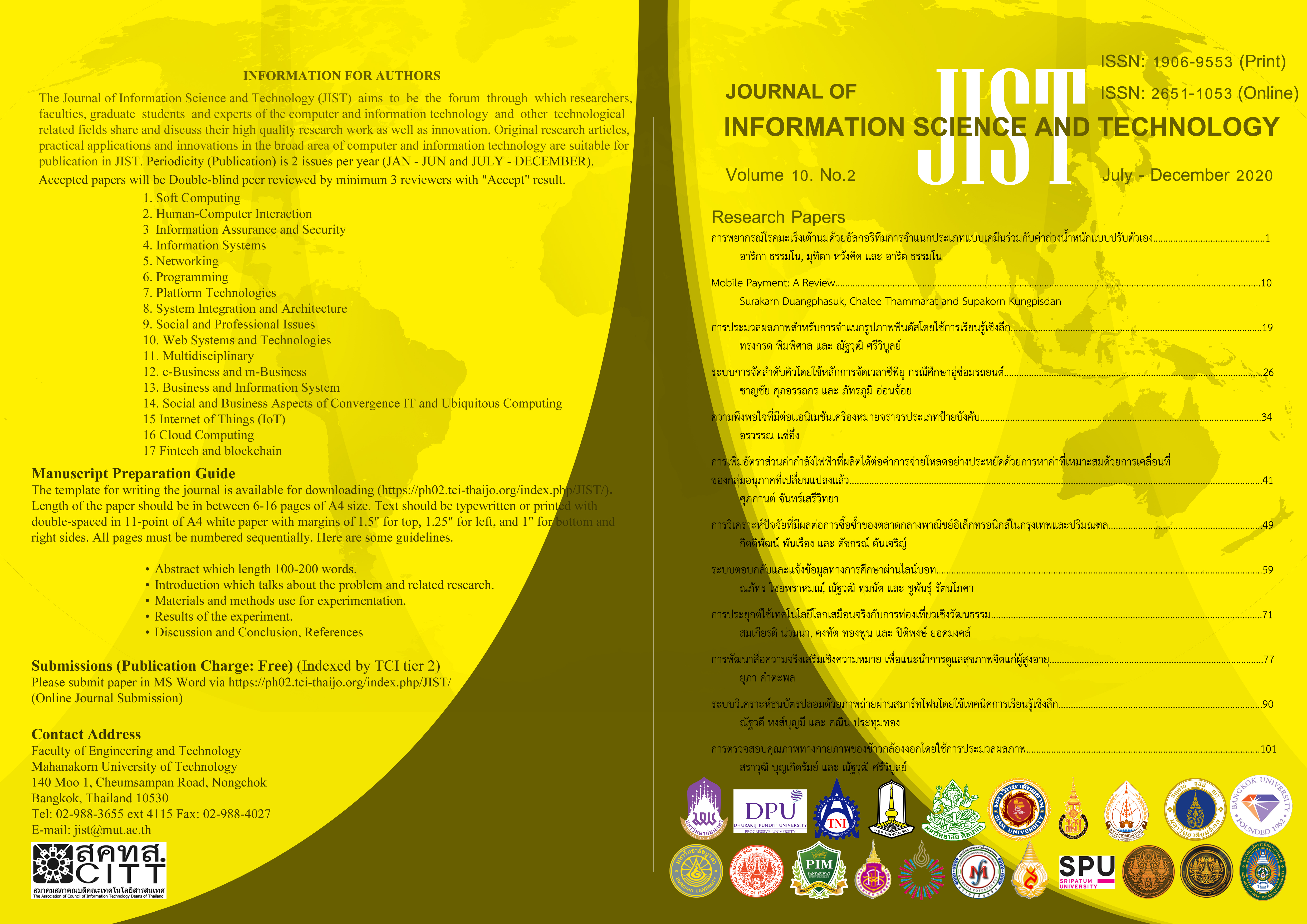Educational Response and Notification System using LINE Bot
Main Article Content
Abstract
Currently, the educational information of King Mongkut's University of Technology North Bangkok is scattered on various websites, causing students to have difficulty accessing necessary information. Thus, this article proposes the design and development of the educational response and notification system called NN Bot (Nice Notification Bot). It is operating on the LINE application. The NN Bot gives students convenient ways of accessing educational information. Moreover, Dialogflow, which is a natural language processing engine, has been applied in the NN Bot to better support user dialogue. The main services of NN Bot are to inquire the teacher teaching schedule, to inquire the student's class schedule, to search the location of the buildings in the university, to inquire the academic results in the current semester, and to notify the academic results to students automatically when the results are approved by the faculty. According to the NN Bot satisfaction survey, the overall result shows that the NN Bot can help students well. Students satisfy the ease of use the most. The average satisfaction overall of NN Bot is 4.39 which is at a good level.
Article Details
This work is licensed under a Creative Commons Attribution-NonCommercial-NoDerivatives 4.0 International License.
I/we certify that I/we have participated sufficiently in the intellectual content, conception and design of this work or the analysis and interpretation of the data (when applicable), as well as the writing of the manuscript, to take public responsibility for it and have agreed to have my/our name listed as a contributor. I/we believe the manuscript represents valid work. Neither this manuscript nor one with substantially similar content under my/our authorship has been published or is being considered for publication elsewhere, except as described in the covering letter. I/we certify that all the data collected during the study is presented in this manuscript and no data from the study has been or will be published separately. I/we attest that, if requested by the editors, I/we will provide the data/information or will cooperate fully in obtaining and providing the data/information on which the manuscript is based, for examination by the editors or their assignees. Financial interests, direct or indirect, that exist or may be perceived to exist for individual contributors in connection with the content of this paper have been disclosed in the cover letter. Sources of outside support of the project are named in the cover letter.
I/We hereby transfer(s), assign(s), or otherwise convey(s) all copyright ownership, including any and all rights incidental thereto, exclusively to the Journal, in the event that such work is published by the Journal. The Journal shall own the work, including 1) copyright; 2) the right to grant permission to republish the article in whole or in part, with or without fee; 3) the right to produce preprints or reprints and translate into languages other than English for sale or free distribution; and 4) the right to republish the work in a collection of articles in any other mechanical or electronic format.
We give the rights to the corresponding author to make necessary changes as per the request of the journal, do the rest of the correspondence on our behalf and he/she will act as the guarantor for the manuscript on our behalf.
All persons who have made substantial contributions to the work reported in the manuscript, but who are not contributors, are named in the Acknowledgment and have given me/us their written permission to be named. If I/we do not include an Acknowledgment that means I/we have not received substantial contributions from non-contributors and no contributor has been omitted.
References
Chatbots Will Appeal to Moderm Workers. [online], Available: https://www.gartner.com/smarterwithgartner/ chatbots-will-appeal-to-modern-workers/. [Accessed: 3 September 2020].
M. Nuruzzaman and O. Hussain, "IntelliBot: A Dialogue-based chatbot for the insurance industry," Knowledge-Based Systems, vol. 196, pp. 105810, 2020.
R. Singh, M. Paste, N. Shinde, H. Patel and N. Mishra, "Chatbot using TensorFlow for small Businesses," 2018 Second International Conference on Inventive Communication and Computational Technologies (ICICCT), Coimbatore, pp. 1614-1619, 2018.
R. V. Belfin, A. J. Shobana, M. Manilal, A. A. Mathew and B. Babu, "A Graph Based Chatbot for Cancer Patients," 2019 5th International Conference on Advanced Computing & Communication Systems (ICACCS), Coimbatore, India, pp. 717-721, 2019.
F. Patel, R. Thakore, I. Nandwani and S. K. Bharti, "Combating Depression in Students using an Intelligent ChatBot: A Cognitive Behavioral Therapy," 2019 IEEE 16th India Council International Conference (INDICON), Rajkot, India, pp. 1-4, 2019.
S. Ondáš, M. Pleva and D. Hládek, "How chatbots can be involved in the education process," 2019 17th International Conference on Emerging eLearning Technologies and Applications (ICETA), Slovakia, pp. 575-580, 2019.
V. Sittakul, S. Judprasong and N. Saengmanee, "Smart Quiz System for Classroom via LINEBot," 2019 Research, Invention, and Innovation Congress (RI2C), Bangkok, Thailand, pp. 1-4, 2019.
A. S. Sreelakshmi, S. B. Abhinaya, A. Nair and S. Jaya Nirmala, "A Question Answering and Quiz Generation Chatbot for Education," 2019 Grace Hopper Celebration India (GHCI), Bangalore, India, pp. 1-6, 2019.
Infographic: LINE Thailand 2019. [online], Available: https://www.thumbsup.in.th/line-th-stats-2019. [Accessed: September 3, 2020].
Dialogflow Documentation. [online], Available: https://cloud.google.com/dialogflow/docs/. [Accessed: September 3, 2020].
Message Types | LINE Developers. [online], Available: https://developers.line.biz/en/docs/messaging-api/message-types. [Accessed: September 3, 2020].
LINE Front-end Framework | LINE Developers. [online], Available: https://developers.line.biz/en/docs/ liff/. [Accessed: September 3, 2020].
The Go Programming Language. [online], Available: https://golang.org/doc/. [Accessed: September 3, 2020].
Gin Web Framework. [online], Available: https://gin-gonic.com/docs/. [Accessed: September 3, 2020].
R. Likert, “A Technique for the Measurement of Attitudes,” Archives of Psychology 140: pp. 1-55, 1932.



